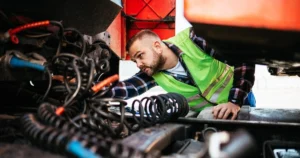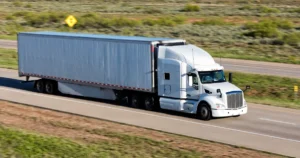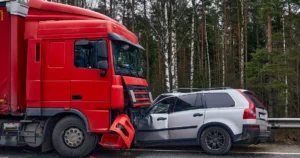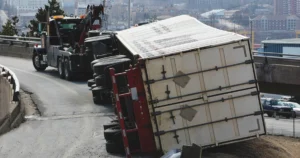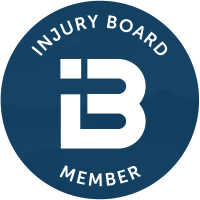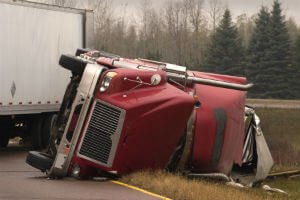 Truck accidents are much different than typical car accidents, due to the sheer weight and size of a commercial truck. Often, the injuries victims sustain in a truck accident tend to be more serious, and fatalities are more likely.
Truck accidents are much different than typical car accidents, due to the sheer weight and size of a commercial truck. Often, the injuries victims sustain in a truck accident tend to be more serious, and fatalities are more likely.
There are also special rules that apply to commercial truck drivers, and many parties may be involved in these types of accidents.
If you were injured in a truck accident, you will need to prove why the truck driver or other party is liable for the accident. Because of the seriousness and costs of these accidents, it is important to consult with an experienced lawyer as soon as possible.
Your truck accident attorney at the law firm of Pfeifer, Morgan & Stesiak can explain how fault is established in a semi-truck accident during a free, no-obligation consultation. We will work to determine if you may be entitled to compensation for your medical expenses, property damage, lost wages, and pain and suffering.
Schedule a free consultation by calling (574) 444-0741 today.
Who Could Be Held Liable in a Semi Truck Accident?
A trucking company often has multiple parties involved in its operation. It is not always clear who bears legal responsibility for a serious or fatal semi-truck accident.
Parties that may be liable for this type of accident include the following:
Truck Driver
Typically, truck drivers are the first party that an experienced lawyer will likely investigate after an accident. This includes reviewing the driver’s behavior during the accident and determining whether he or she may have violated state or federal laws, such as the Federal Motor Carrier Safety Administration’s (FMCSA) hours of service rule. Even a small amount of drugs or alcohol can impair a truck driver’s ability to safely operate a vehicle and is a strict violation of the FMCSA’s drug and alcohol regulations.
Furthermore, the truck driver may have disobeyed traffic laws, such as violating speed limits, failing to follow yield signs or ignoring other traffic signs or signals. Truck drivers also have many blind spots and may not have properly looked around the truck before changing lanes or merging.
Trucking Company
Another party that could be at fault is the trucking company. This may depend on whether the truck’s driver is an employee or an independent contractor, or if the trucking company owns the semi-truck involved in your accident.
If the truck driver is an employee for a trucking company instead of an independent contractor, the company may be liable for the actions of the truck driver. Trucking companies are required to ensure that the drivers they hire have the appropriate training and credentials to safely operate a semi-truck.
Furthermore, trucking companies are required to regularly test their drivers for drug or alcohol use before a long-distance haul and after an accident. If a trucking company fails to uphold these obligations, it could be held liable for an accident.
Cargo Company
A separate company may be responsible for loading cargo onto the truck. This company is also responsible for safely securing the contents inside the vehicle.
A cargo company may be held liable if the cargo was not secured properly, was exposed, fell from the back of the truck or caused the semi-truck to tip over because of improper weight distribution.
Manufacturer
If the truck or any of its parts were defective, the manufacturer may be held liable for the accident. For example, if the accident was caused by a steering system failure, brake failure, defective hitch or tire blowout, the part’s manufacturer may be responsible.
Comparative Fault
In some truck accident cases, the driver of the passenger vehicle may also bear some fault for the crash. Pennsylvania’s comparative fault system prohibits personal injury victims from recovering compensation if they are 51 percent or more at fault for their injury.
If the driver is less than 51 percent at fault, he or she can recover compensation for the accident. However, the recovery amount is reduced by his or her percentage of fault.
For example, if a driver is 30 percent at fault for the accident, his or her maximum recovery is reduced by 30 percent. If there are multiple parties who are partially liable, each will be held liable for damages proportionate to its own percentage of responsibility.
Evidence for Proving Fault
Because there may be multiple parties involved, it is important to have clear evidence that establishes legal responsibility for the truck accident.
It is important to have a skilled personal injury lawyer on your side who can help substantiate your claim by evidence such as:
- The truck’s “black box”
- The truck’s camera
- Vehicle damage
- Physical evidence from the truck, other vehicles and the accident scene
- Employee records
- Drug and alcohol screening results
- Truck driver logs
- Cargo records
- Truck maintenance logs
- Eyewitness reports
- Accident report
- Medical records
- National Transportation Safety Board investigation report
This evidence may help show how the truck driver, trucking company or other party was responsible for the accident. That is why it is critical to hire an experienced truck accident lawyer as soon as possible to ensure that this evidence can be preserved and documented.
Contact a Lawyer for Assistance
The trusted lawyers at Pfeifer, Morgan & Stesiak can immediately begin to take steps to protect your truck accident claim.
We have a strong understanding of what types of evidence are necessary to establish the at-fault party’s negligence after a truck accident. Call our legal team today to schedule a free, no-obligation consultation to learn more about your legal options.
Call (574) 444-0741
so we can get started on your claim.

